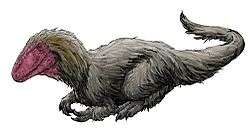Siats
| Siats Temporal range: Late Cretaceous, 98.5 Ma | |
|---|---|
 | |
| Restoration | |
| Scientific classification | |
| Kingdom: | Animalia |
| Phylum: | Chordata |
| Class: | Reptilia |
| Clade: | Dinosauria |
| Order: | Saurischia |
| Suborder: | Theropoda |
| Family: | †Neovenatoridae |
| Clade: | †Megaraptora |
| Genus: | †Siats Zanno & Makovicky, 2013 |
| Type species | |
| †Siats meekerorum Zanno & Makovicky, 2013 | |
Siats is an extinct genus of large megaraptoran theropod dinosaur known from the Late Cretaceous Cedar Mountain Formation of Utah, US. It contains a single species, Siats meekerorum. S. meekerorum could be the first neovenatorid discovered in North America and the geologically youngest allosauroid yet discovered from the continent.[1] However, recent phylogenetic analyses find that megaraptorans are either tyrannosauroids,[2] allosauroids, or basal coelurosaurs.[3] More recent studies indicate that megaraptorans like Siats were indeed carnosaurs and were also part of the Neovenatoridae, albeit, ones that evolved tyrannosauroid-like features through convergent evolution.[4]
Discovery
Siats was first described and named by Lindsay E. Zanno and Peter J. Makovicky in 2013 and the type species is Siats meekerorum. The generic name is derived from the name of Siats, a man-eating monster in the Ute mythology.[1] The specific name meekerorum honours the late geologist John Caldwell Meeker who bequeathed a fund for the support of paleontological research, his widow Withrow Meeker and their daughter Lis Meeker, one of the volunteers in the research project.[1]
Siats is known from the holotype FMNH PR 2716, a partial postcranial skeleton housed at the Field Museum of Natural History, Chicago. FMNH PR 2716 consists of five dorsal and eight caudal vertebrae, a chevron, partial right ilium, ischium and fibula, a partial left tibia, and several right and left pedal phalanges.[1] FMNH PR 2716 was discovered by Lindsay Zanno, as a part of a 2008 expedition of the Field Museum led by Peter Makovicky.[5] It was collected between 2008 and 2010 from the Mussentuchit Member of the Cedar Mountain Formation, in Emery County of Utah, dating to the early Cenomanian stage of the Late Cretaceous, approximately 98.5 million years ago.
Description
The holotype came from a single immature individual, based on the incomplete fusion of neural arches to their centra in the vertebral column. Siats is characterized by seven diagnostic, including four autapomorphic (i.e. unique), traits. Its autapomorphies include the subtriangular cross section of the distal caudal vertebrae, elongated centrodiapophyseal laminae lacking noticeable infradiapophyseal fossae on the proximal caudals, a transversely concaved acetabular rim of iliac pubic peduncle, and the presence of a notch on the end of the truncated lateral brevis shelf. Other notable traits include the broad neural spines on the dorsal vertebrae.[1]
Siats represents one of the largest known theropods from North America. Zanno and Mackovicky (2013) using other megaraptoran taxa as a proxy, estimate the femur length of the holotype specimen FMNH PR 2716 at 11.9 meters long, and using a femur circumference regression, estimate its mass at roughly 4 tons. Zanno and Mackovicky also wrote that the holotype specimen was already comparable in size to Saurophaganax and Acrocanthosaurus despite the visible neurocentral sutures showing absence of ossification, suggesting a skeletally immature individual. If it is a neovenatorid, the discovery of Siats also reveals that allosauroids did not yield dominance in North America to tyrannosauroids until the late Cretaceous.[6] However, until 2016, there was substantial disagreement on the classification of megaraptorans, which were usually found to be either neovenatorids or tyrannosauroids. However, studies of other megaraptorans reveal that they were carnosaurs that had evolved independent similarities with the tyrannosauroids.[4]
Phylogeny
The cladogram presented below follows Zanno & Makovicky (2013).[1]
| Allosauroidea |
| |||||||||||||||||||||||||||||||||||||||||||||||||||||||||||||||||||||||||||||||||||||||||||||||||||||||||||||||||||||||||||||||||||||||||||||
| |
References
- 1 2 3 4 5 6 Zanno, L. E.; Makovicky, P. J. (2013). "Neovenatorid theropods are apex predators in the Late Cretaceous of North America". Nature Communications. 4: 2827. Bibcode:2013NatCo...4E2827Z. doi:10.1038/ncomms3827. PMID 24264527.
- ↑ F. E. Novas; F. L. Agnolín; M. D. Ezcurra; J. I. Canale; J. D. Porfiri (2012). "Megaraptorans as members of an unexpected evolutionary radiation of tyrant-reptiles in Gondwana". Ameghiniana. 49 (Suppl.): R33.
- ↑ http://journals.plos.org/plosone/article?id=10.1371/journal.pone.0157793
- 1 2 https://museumvictoria.com.au/pages/381424/049-061_MMV74_Novas_4_WEB.pdf
- ↑ Johnson, Steve (22 November 2013). "New dinosaur discovered by Field Museum expedition". Chicago Tribune. Retrieved 22 November 2013.
- ↑ Jha, Ajit (22 November 2013). "'Man-Eating Monster' Dinosaur Was Top Predator Before T. Rex; Discovery Solves 30 Million Year-Old Puzzle". International Science Times. Retrieved 24 November 2013.
